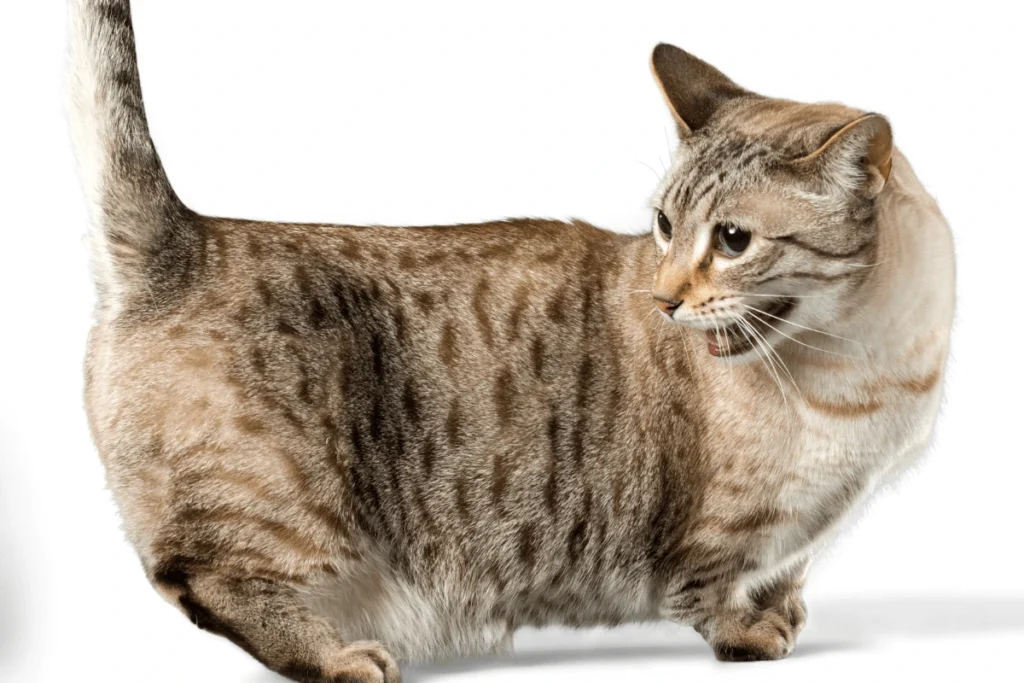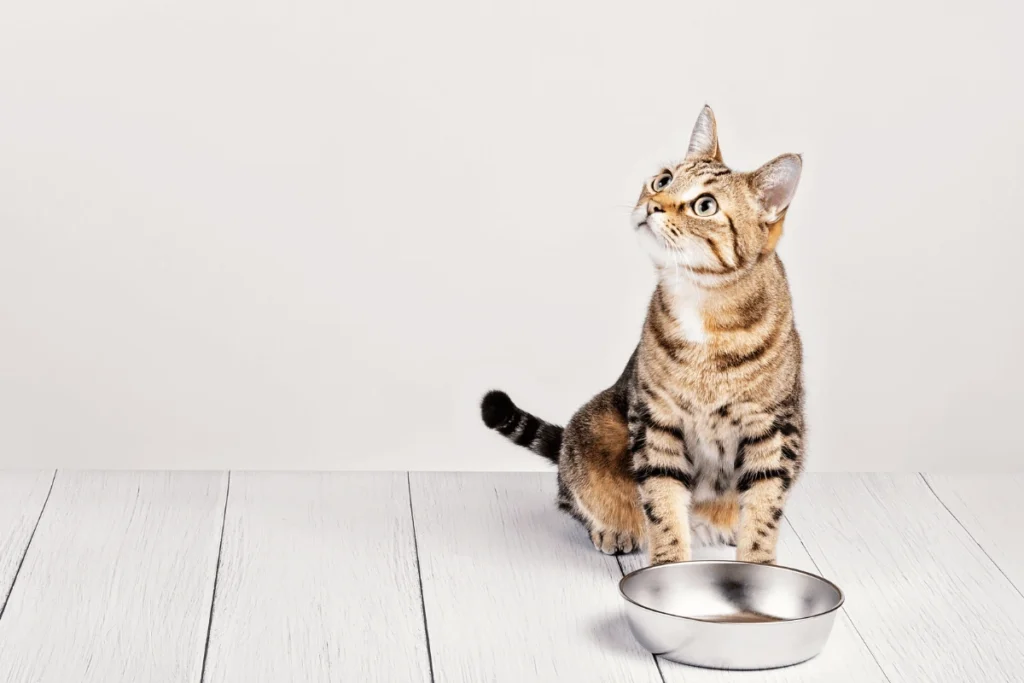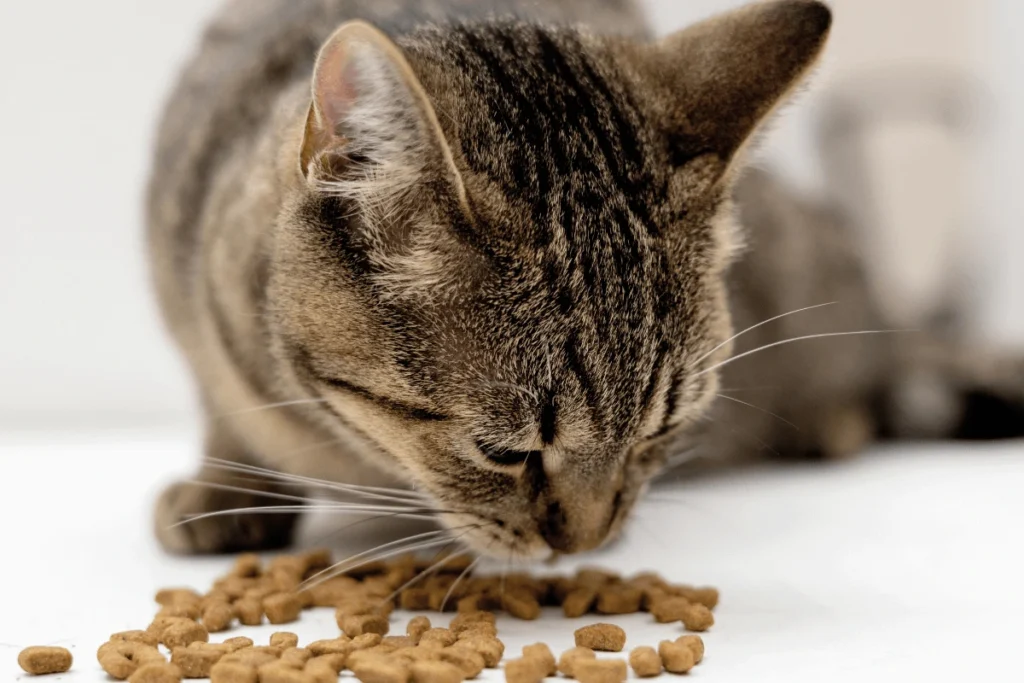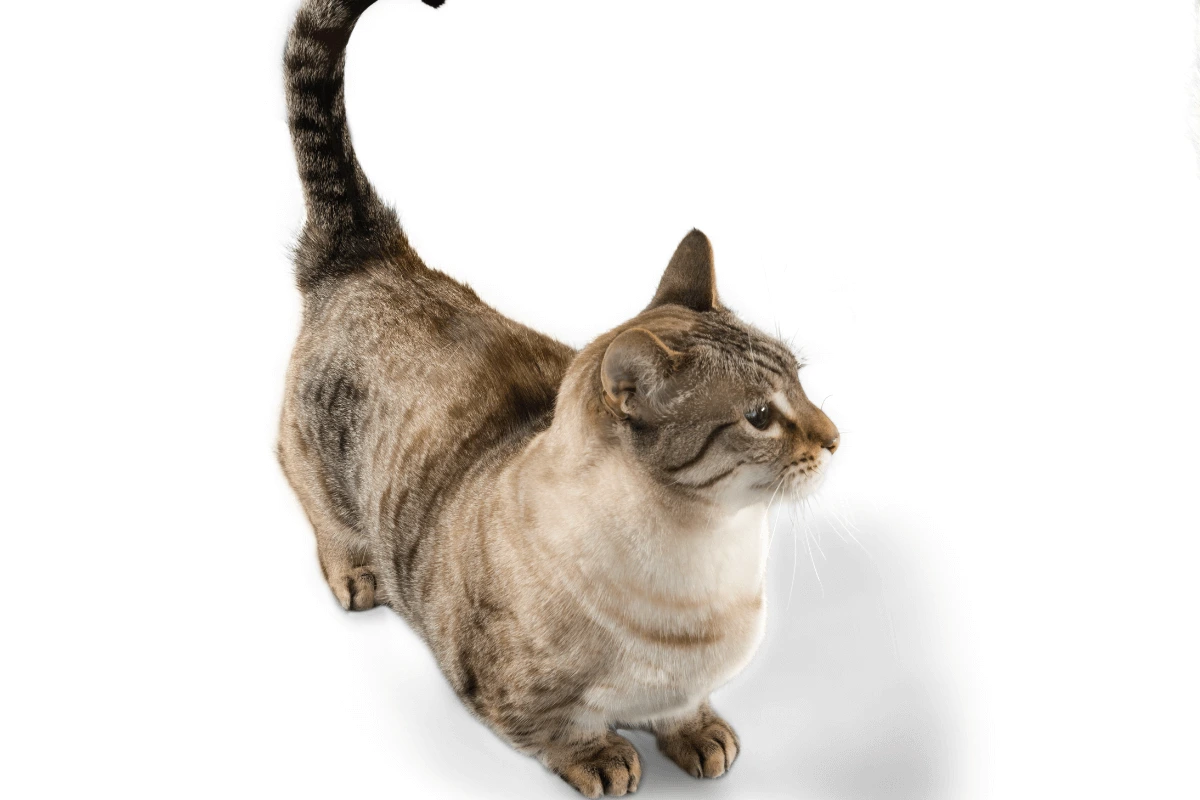Munchkin cats are a special and cute type of cat. They have short legs and are very playful.. However, their distinctive genetic traits come with specific challenges, making Munchkin cat health problems an important topic for any owner to understand. These small but lively cats require special care to ensure they live a long, comfortable, and happy life.
Because of their genetic makeup, Munchkin cats are more prone to mobility issues, joint pain, and spinal disorders. Some of the most common concerns include osteoarthritis, lordosis (a condition affecting the spine), and pectus excavatum (a chest deformity). Without proper care and attention, these health problems can affect their quality of life, making it crucial for owners to be proactive in their pet’s well-being.
This guide will cover essential Munchkin cat care tips to help prevent and manage health issues. From proper nutrition and exercise to regular vet check-ups and home adjustments, these ten expert-backed tips will keep your Munchkin cat healthy and happy. Let’s dive in!
Understanding Munchkin Cat Health Problems
Genetic Factors Affecting Munchkin Cats
Munchkin cats inherit their short legs from a natural genetic mutation. This dominant gene affects bone growth, specifically in the legs, which gives them their signature short stature. However, this same genetic trait can also contribute to several Munchkin cat health problems, including joint and spine issues. Unlike other cat breeds, Munchkins have a higher risk of developing skeletal abnormalities, which can impact their mobility as they age.
Since the gene responsible for their short legs is dominant, breeding two Munchkin cats together can be risky. When two Munchkin cats carry the same gene, their offspring may not survive due to severe genetic complications. Ethical breeders avoid this by pairing Munchkin cats with non-Munchkin cats to maintain genetic diversity and reduce the chances of severe Munchkin cat health problems. Understanding these genetic risks helps owners provide better care and recognize early signs of health issues before they become severe.
Common Health Issues in Short-Legged Cat Breeds
Munchkin cats may look small and agile, but their short legs can lead to serious health concerns. One of the most common Munchkin cat health problems is osteoarthritis, a painful condition that affects their joints over time. Because their legs are shorter than a typical cat’s, their bodies distribute weight differently, putting extra stress on their joints and increasing wear and tear.

Another major issue is lordosis, a condition where the spine curves excessively inward due to weak muscles supporting the spine. This can cause difficulty in movement and, in severe cases, can impact vital organs. Pectus excavatum is another health concern found in some Munchkin cats, where the chest appears sunken, potentially leading to breathing difficulties. These health problems highlight the importance of regular check-ups and preventive care to maintain a Munchkin cat’s well-being.
How Feline Genetics Impact Their Mobility and Lifespan
Feline genetics play a significant role in determining how well a Munchkin cat moves and how long it lives. The short-legged gene may make these cats look adorable, but it can also limit their ability to jump as high or move as swiftly as other breeds. Unlike long-legged cats, Munchkins rely more on running and climbing at lower heights rather than leaping to high places. Owners should provide pet ramps and soft surfaces to make movement easier while preventing injuries related to Munchkin cat health problems.
Despite their genetic challenges, Munchkin cats can live healthy and fulfilling lives when given proper care. Their lifespan typically ranges from 12 to 15 years, similar to other cat breeds, but factors like diet, exercise, and regular veterinary visits play a crucial role in their longevity. Early detection of Munchkin cat health problems allows owners to manage conditions before they worsen, ensuring a better quality of life for these unique felines.
By understanding the genetic factors behind Munchkin cat health problems, owners can take the right steps to support their pet’s health and happiness. Proper care, ethical breeding, and early intervention make all the difference in ensuring a Munchkin cat enjoys a long and active life.
Common Joint and Spine Issues in Munchkin Cats
Osteoarthritis in Munchkin Cats
Osteoarthritis is one of the most common Munchkin cat health problems, primarily affecting their joints due to their unique body structure. The genetic mutation that gives Munchkin cats their short legs also puts extra strain on their joints, leading to faster cartilage deterioration. As the cartilage wears down, bones begin to rub against each other, causing pain, stiffness, and reduced mobility.
Early signs of osteoarthritis include reluctance to jump, difficulty climbing stairs, and stiffness after resting. Some Munchkin cats may become less active or avoid certain movements that cause discomfort. If left untreated, the condition can worsen, making it painful for the cat to walk or play. Owners can help manage osteoarthritis by providing soft bedding, maintaining a healthy weight, and incorporating joint supplements like glucosamine and chondroitin into their cat’s diet.
Regular exercise plays a crucial role in keeping a Munchkin cat’s joints flexible. However, excessive jumping or rough play can accelerate joint damage, so interactive toys that encourage gentle movement are a better choice. A veterinarian can also recommend pain management options, such as anti-inflammatory medications or physical therapy, to improve a cat’s comfort and quality of life. By addressing osteoarthritis early, owners can prevent unnecessary pain and keep their Munchkin cat active for years.
Lordosis: A Spinal Condition in Munchkin Cats
Lordosis is another serious Munchkin cat health problem that affects the spine. This condition occurs when the spinal muscles fail to develop properly, causing the spine to curve excessively inward. While lordosis can appear in any cat breed, Munchkin cats are at a higher risk due to their genetic makeup. In severe cases, this spinal curvature can press against internal organs, leading to breathing difficulties and other complications.
Kittens born with severe lordosis may struggle to grow normally and might show signs of weakness or difficulty moving. In milder cases, Munchkin cats may live relatively normal lives but could develop mobility issues as they age. Signs of lordosis include an exaggerated dip in the back, difficulty walking, and labored breathing.
Veterinarians diagnose lordosis through X-rays and physical examinations. Unfortunately, there is no cure for this condition, but supportive care can help affected Munchkin cats live more comfortably. Soft sleeping areas, ramps instead of stairs, and a diet rich in essential nutrients can reduce strain on the spine. Some cats may benefit from physical therapy to strengthen muscles and improve posture. Understanding lordosis allows owners to monitor their cat’s mobility and make adjustments to ensure a pain-free, happy life.
Pectus Excavatum in Munchkin Cats
Pectus excavatum, commonly known as “funnel chest,” is a deformity where the cat’s ribcage develops abnormally, creating a sunken chest appearance. This Munchkin cat health problem varies in severity—some cats show only mild indentation, while others experience significant compression of the heart and lungs, making it difficult to breathe.
Owners should watch for signs such as labored breathing, reduced stamina, and a noticeable dip in the chest. Kittens with severe pectus excavatum may struggle to nurse and grow at a normal rate. Since Munchkin cats already have a unique skeletal structure, this condition can add extra challenges to their overall health.
Veterinarians diagnose pectus excavatum through physical exams and imaging tests like X-rays. Mild cases may not require treatment, but severe cases might need corrective surgery to expand the chest cavity and allow better organ function. Post-surgical care includes a comfortable recovery space, pain management, and follow-up checkups to monitor healing.
Owners can help prevent complications by ensuring their Munchkin cat maintains a healthy weight and avoids excessive physical stress. Since this condition is often genetic, responsible breeding practices play a key role in reducing the chances of pectus excavatum appearing in future generations.
Essential Munchkin Cat Care Tips for a Healthy Life
Importance of Regular Veterinarian Check-Ups
Regular vet visits play a crucial role in preventing and managing Munchkin cat health problems. Because of their unique body structure, Munchkin cats need frequent check-ups to detect early signs of joint pain, spinal conditions, and mobility issues. A veterinarian can monitor their bone and muscle health, ensuring that any developing problems receive immediate attention.
Annual wellness exams allow vets to assess a Munchkin cat’s overall condition, checking for osteoarthritis, lordosis, and pectus excavatum. These exams often include X-rays, blood tests, and joint mobility assessments. Catching these issues early can help owners implement lifestyle changes and treatments before the cat experiences severe discomfort.
Aside from mobility concerns, Munchkin cats also require routine vaccinations, dental care, and parasite prevention. A vet can recommend a diet that supports joint health and overall wellness, ensuring that the cat gets essential nutrients. If a Munchkin cat shows signs of limping, stiffness, or breathing difficulties, a veterinarian should evaluate these symptoms immediately. Consistent medical care extends a Munchkin cat’s lifespan and keeps it comfortable throughout its life.
Creating a Comfortable Environment for Mobility Issues
Because of their short legs, Munchkin cats navigate their surroundings differently from other breeds. Owners need to create a home environment that minimizes stress on their joints and spine, reducing the risk of Munchkin cat health problems like arthritis and spinal curvature disorders.
Jumping onto high surfaces can be challenging for Munchkin cats, and repeated attempts may strain their joints. Pet ramps and low-step platforms allow them to climb onto furniture safely. Soft bedding also plays a crucial role in reducing pressure on their joints while they rest. Memory foam or orthopedic pet beds provide better support for Munchkin cats with osteoarthritis or mobility limitations.
Smooth, non-slip flooring helps prevent unnecessary joint strain. Hardwood or tile floors can be slippery, making it difficult for Munchkin cats to walk without skidding. Adding carpets, rugs, or rubber mats creates better traction, reducing the likelihood of falls and joint injuries.
A well-designed environment allows a Munchkin cat to move comfortably and independently. By adjusting their home setup, owners can prevent unnecessary stress on their cat’s body and improve their overall quality of life.
Exercise and Playtime: Keeping Your Munchkin Cat Active
Regular activity is essential for preventing weight gain and maintaining strong muscles in Munchkin cats. Extra weight puts added stress on their short legs, worsening Munchkin cat health problems like arthritis and spinal conditions. Exercise strengthens their muscles, improves flexibility, and helps them stay energetic.
Unlike long-legged cats, Munchkin cats may not jump as high, but they still love to run, chase, and climb small obstacles. Owners should encourage low-impact activities that engage their cat’s natural instincts without straining their joints. Interactive toys like feather wands and laser pointers keep them moving while providing mental stimulation.
Cat tunnels and low-height climbing structures offer fun exercise options that don’t require high jumps. Puzzle feeders and treat-dispensing toys encourage movement while stimulating their brains. Short, frequent play sessions work best, as long periods of activity can overwork their joints.
Owners should avoid forcing Munchkin cats to perform strenuous activities, like jumping onto high platforms or running up and down stairs repeatedly. Instead, they should focus on gentle movement to keep their cat healthy without causing unnecessary stress on their bones and joints. Regular playtime improves a Munchkin cat’s overall well-being, keeping them happy, active, and mentally engaged.
By incorporating vet check-ups, a comfortable environment, and the right exercise routine, owners can effectively prevent common Munchkin cat health problems and ensure their feline friend enjoys a long, fulfilling life.
Nutrition and Diet for Munchkin Cats
Key Nutrients to Support Joint and Bone Health
Munchkin cats need a well-balanced diet that supports their unique skeletal structure. Because of their short legs, their joints and bones endure more stress than those of longer-legged breeds. Without proper nutrition, they become more vulnerable to Munchkin cat health problems like osteoarthritis and mobility issues. Providing essential nutrients helps maintain strong bones, reduce inflammation, and keep their joints flexible.

Glucosamine and chondroitin play a crucial role in joint health. These compounds help maintain cartilage, the protective tissue that cushions bones and prevents them from rubbing against each other. Many high-quality cat foods include these ingredients, but supplements can also provide additional support.
Omega-3 fatty acids, found in fish oil and certain meats, help reduce joint inflammation and stiffness. These healthy fats also improve coat health, keeping a Munchkin cat’s fur shiny and soft. Calcium and phosphorus support bone strength, but they must be balanced correctly. Too much phosphorus without enough calcium can weaken bones, increasing the risk of fractures or spinal problems.
Vitamin D helps the body absorb calcium, while magnesium plays a role in muscle function and bone development. Including these nutrients in a Munchkin cat’s diet prevents common health problems in short-legged cat breeds and promotes long-term mobility.
Best Food Choices for Maintaining a Healthy Weight
Weight management plays a significant role in preventing Munchkin cat health problems, especially joint pain and mobility issues. Excess weight adds stress to their short legs, increasing the likelihood of arthritis and other skeletal disorders. Feeding the right foods helps maintain a healthy weight and supports overall well-being.
High-quality protein should be the foundation of a Munchkin cat’s diet. Lean meats like chicken, turkey, and fish provide essential amino acids that maintain muscle strength without unnecessary fat. Cats are obligate carnivores, meaning they need animal-based protein to stay healthy.
Avoid high-carbohydrate foods, as excessive carbs contribute to weight gain. Many commercial cat foods contain fillers like corn, wheat, and soy, which provide little nutritional value. Instead, choose grain-free or low-carb formulas that prioritize meat-based ingredients.
Portion control also plays a key role in weight management. Overfeeding leads to obesity, which worsens Munchkin cat health problems like osteoarthritis and mobility issues. Measuring meals and following feeding guidelines based on the cat’s weight and activity level prevents unnecessary weight gain.

Wet food provides a great option for maintaining hydration and controlling calorie intake. It has a higher moisture content, keeps cats feeling full, and usually contains fewer carbohydrates than dry kibble. Feeding a balanced mix of wet and dry food ensures that a Munchkin cat gets the necessary nutrients without excessive calories.
Hydration and Its Role in Preventing Health Issues
Proper hydration supports a Munchkin cat’s overall health and helps prevent common Munchkin cat health problems like kidney disease, urinary tract infections, and joint stiffness. Cats naturally have a low thirst drive, which means they may not drink enough water on their own. Ensuring adequate hydration keeps their organs functioning properly and reduces the risk of health complications.
Water plays a crucial role in maintaining joint lubrication. When a cat becomes dehydrated, its joints lose flexibility, increasing stiffness and discomfort. Since Munchkin cats already experience extra stress on their joints, keeping them hydrated helps minimize mobility problems.
Wet food provides an excellent source of hydration, as it contains about 70-80% water. Cats that eat primarily dry kibble need access to fresh water at all times. Some Munchkin cats prefer running water, so a pet fountain can encourage them to drink more. Adding a small amount of water to dry food can also help increase their fluid intake.
Electrolytes like potassium and sodium help regulate hydration levels. While most high-quality cat foods contain these minerals in balanced amounts, severe dehydration may require electrolyte supplements under a veterinarian’s guidance.
By focusing on proper hydration, high-quality nutrition, and weight management, owners can significantly reduce Munchkin cat health problems and help their feline companions lead longer, healthier lives.
Enhancing Your Munchkin Cat’s Quality of Life
Proper Grooming and Hygiene Practices
Maintaining proper grooming and hygiene practices is essential for preventing Munchkin cat health problems and ensuring overall well-being. Because of their short legs, Munchkin cats may struggle with self-grooming, especially in hard-to-reach areas. Owners should take extra care to help keep their coats clean, their nails trimmed, and their ears free from infections.
Brushing a Munchkin cat’s coat regularly helps remove dirt, loose fur, and potential tangles. While Munchkin cats come in both short-haired and long-haired varieties, long-haired Munchkins require more frequent brushing to prevent matting and skin irritation. Using a soft-bristle brush or a grooming glove two to three times a week keeps their coat healthy and reduces shedding. Regular brushing also minimizes hairballs, a common issue in cats that groom themselves excessively.
Nail trimming is another important grooming task. Because of their short legs, Munchkin cats have a different posture than long-legged breeds, which can cause their nails to wear down less naturally. Overgrown nails may lead to discomfort, difficulty walking, or even joint pain. Trimming their nails every two to three weeks prevents these issues and keeps their paws in good condition.
Ear cleaning should be a part of every Munchkin cat’s hygiene routine. Their unique body structure may make it harder for them to clean their ears naturally, leading to wax buildup or infections. Checking their ears weekly and wiping them gently with a vet-approved cleaner helps prevent infections and ensures their ears stay healthy.
Dental care also plays a significant role in preventing Munchkin cat health problems. Gum disease and plaque buildup can lead to more severe health issues, including infections that may affect the heart and kidneys. Brushing their teeth with feline-friendly toothpaste or providing dental treats helps maintain oral hygiene and prevents painful dental diseases.
By incorporating these grooming and hygiene practices, owners can help their Munchkin cats stay clean, comfortable, and free from preventable health issues.
Safe Spaces and Furniture Adaptations for Short-Legged Cats
Because of their unique body structure, Munchkin cats require a home environment that accommodates their short legs and limited jumping ability. Owners should make adjustments to furniture and living spaces to reduce the risk of Munchkin cat health problems related to joint strain, falls, and mobility issues.
Jumping onto high surfaces can be difficult for Munchkin cats, and repeated attempts may put stress on their joints. Providing pet ramps, low step platforms, or sturdy stools allows them to reach furniture, windowsills, or beds without excessive strain. Soft cushions or padded landings help reduce the impact when they jump down, protecting their bones and joints from unnecessary wear.
Scratching posts and climbing structures should be lower or designed with accessible steps. Traditional cat trees with tall perches may not be suitable for Munchkin cats unless they include ramps or gradual levels. Choosing a cat tree with multiple low platforms allows them to climb and explore safely.
Litter box placement is another important factor to consider. Munchkin cats may struggle with high-sided litter boxes, especially as they age and develop joint stiffness. A low-entry litter box makes it easier for them to step in and out comfortably while maintaining good hygiene.
Creating a safe and accessible environment minimizes the risk of mobility issues, joint strain, and spinal problems, allowing Munchkin cats to navigate their surroundings comfortably. Thoughtful furniture adaptations ensure that they can enjoy their home without unnecessary physical stress.
Monitoring Signs of Discomfort and When to See a Vet
Early detection of health issues plays a crucial role in managing Munchkin cat health problems. Because of their unique skeletal structure, Munchkin cats may develop mobility-related conditions, joint pain, or spinal issues over time. Monitoring subtle changes in behavior, movement, and appetite helps owners recognize when their cat may be experiencing discomfort.
One of the earliest signs of pain or joint issues is reluctance to jump or climb. If a Munchkin cat suddenly avoids using furniture or struggles with steps, it may be experiencing joint pain or stiffness. A decrease in activity levels, excessive resting, or hesitation before moving can also indicate discomfort.
Limping, stiffness, or an unusual walking pattern may suggest osteoarthritis, lordosis, or another skeletal issue. Munchkin cats with joint pain may also lick or chew their paws and legs excessively in an attempt to soothe discomfort. If an owner notices changes in their cat’s gait or posture, a veterinary examination is necessary to rule out underlying health conditions.
Breathing difficulties, rapid fatigue, or a sunken chest appearance may indicate pectus excavatum, a genetic condition affecting the ribcage. Labored breathing, wheezing, or frequent coughing should never be ignored, as they may signal a serious issue requiring immediate veterinary attention.
Weight changes, either sudden gain or loss, can impact Munchkin cat health problems significantly. Excess weight increases the strain on their joints, while unexplained weight loss could be a sign of an underlying illness. Regular weight monitoring ensures that a Munchkin cat maintains a healthy body condition.
If a Munchkin cat shows signs of discomfort, pain, or reduced mobility, scheduling a veterinary appointment as soon as possible helps prevent further complications. Early diagnosis allows for better treatment options and improves their overall quality of life.
By staying vigilant and recognizing the early signs of health issues, owners can ensure that their Munchkin cats receive the care they need to stay active, comfortable, and happy for years to come.
Conclusion: Ensuring a Healthy and Happy Life for Your Munchkin Cat
Caring for a Munchkin cat requires a proactive approach to prevent Munchkin cat health problems and ensure a long, happy life. Because of their short legs and unique skeletal structure, they face a higher risk of joint pain, mobility issues, and genetic conditions like lordosis, osteoarthritis, and pectus excavatum. Owners who prioritize proper nutrition, regular veterinary care, and a supportive living environment can significantly improve their cat’s quality of life.
A well-balanced diet that includes essential nutrients like glucosamine, chondroitin, omega-3 fatty acids, and high-quality protein helps maintain strong joints and bones. Keeping a Munchkin cat at a healthy weight reduces the risk of arthritis and spinal stress. Hydration also plays a critical role in preventing kidney disease and maintaining joint flexibility.
Routine veterinary check-ups allow early detection of common health issues in short-legged cat breeds. Regular monitoring for signs of discomfort, such as limping, reduced activity, or breathing difficulties, helps owners address potential health concerns before they become severe. Grooming, dental care, and hygiene practices further support a Munchkin cat’s overall well-being.
Creating a home environment with low ramps, soft bedding, and accessible litter boxes makes movement easier and prevents unnecessary strain on their joints. Encouraging gentle play and exercise helps maintain mobility while keeping them mentally and physically stimulated.
By taking these steps, owners can minimize Munchkin cat health problems and provide a comfortable, enriched life. With the right care, Munchkin cats can thrive, bringing years of joy, affection, and companionship to their families.
You Can Read More About the Munchkin Cat Breed here.
Discover Everything Concerning Cats and breeds From HERE!
Find The Best Stuff for your Pets on PetMD

1 thought on “Munchkin Cat Health Problems: 10 Tips for a Healthy & Happy Cat”
Comments are closed.